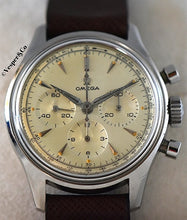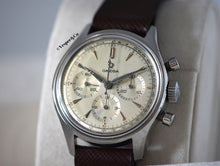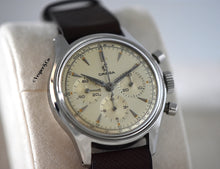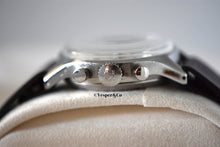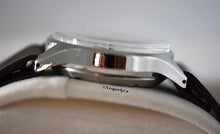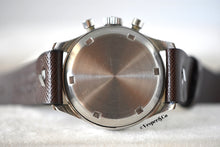
An Omega Caliber 321 chronograph
Reference: 2451-7
Circa: 1950s
Movement: Manual-wind Caliber 321 with column wheel
Case: 36mm, stainless steel, with screw-down case back; push/pull winding crown at 3 o'clock with Omega symbol; push-down chronograph pushers at 2 o'clock and 4 o'clock
Dial: Cream-colored with overall patina; baton hour indicators; chronograph registers at 3, 6, and 9 o'clock in sub-seconds, hours, and minutes; outer telemeter ring; hour, minute, and sweeping chronograph second hands show some signs of age
More about Omega:
Omega introduced the venerable caliber 321 movement in 1942. It was the result of project "27 Chro C12," a collaboration between Omega and ébauche manufacturer Lemania with the aim to develop a 27mm chronograph movement. The result is this elegant movement, the smallest chronograph movement at the time, whose size belies its 50-hour power reserve.
With a column wheel and a "wishbone" shaped bridge, the cal. 321 was used by Omega in its Speedmaster, Seamaster, and DeVille lines. This is the movement which powered the Speedmaster Professional in 1968, the famed "moon watch." It attracted the attention of Patek Philippe and Vacheron Constantin as well, and was used as the base movement for most high-end modern Patek chronographs until 2010.
The present example, though not a part of any named Omega line, nevertheless proves a sterling example of this reputable movement. Of note is the telemeter in base miles, a departure from the usual tachymeter. At 36mm it would make a handsome addition to any collection.






